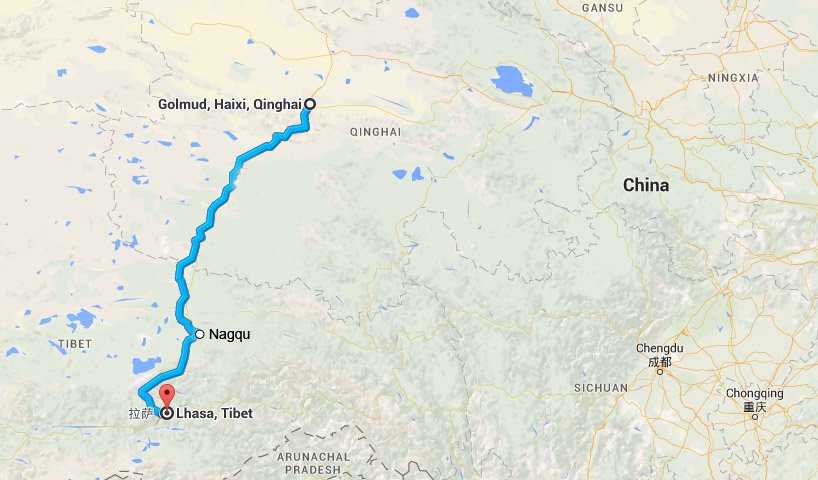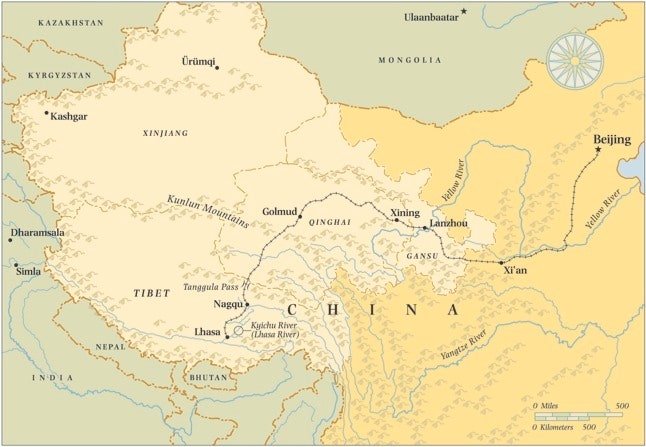Golmud to Lhasa: A Thrilling Train Adventure Through the Tibetan Wilderness

Journey through the remarkable landscapes of Tibet in a unique and remarkable way by embarking on a train ride from Golmud to Lhasa. This train journey offers an exceptional opportunity to witness the awe-inspiring Tibetan wilderness’s surreal beauty while traveling through a variety of terrains.

A Chronicle of the Journey

The train departs from Golmud, a city in Qinghai Province, and embarks on a 2,000-kilometer journey to Lhasa, the capital city of Tibet. Along its course, the train traverses incredible sceneries that portray the diversity of the Tibetan landscape.
Tibetan Plateau’s Expansive Plains
As the train leaves Golmud, it begins a journey across the vast Tibetan Plateau’s expansive plains. These vast and serene, high-altitude grasslands present a breathtaking spectacle, extending as far as the eye can perceive. The tranquility and open spaces of the plains provide a relaxing atmosphere to enjoy the landscape.
Majestic Mountain Ranges
En route, the train encounters the majestic Kunlun and Tanggula mountain ranges. These towering titans of nature form a formidable backdrop against the blue sky. The train navigating through the mountain passes offers moments of awe and inspiration, allowing travelers to immerse themselves in the region’s grandeur.
The Astonishing Kekexili National Nature Reserve
The train journey also traverses the awe-inspiring Kekexili National Nature Reserve, renowned for its pristine environment and abundant wildlife. Diverse species such as Tibetan antelopes, Tibetan yaks, and snow leopards roam this park, providing unique wildlife-viewing experiences.
The Stunning Tibetan Plateau with its High-Altitude Lakes
At various points during the journey, the train passes by picturesque high-altitude Tibetan lakes, each possessing distinct characteristics. Some lakes exude a serene tranquility, while others captivate observers with their vivid turquoise hues. These serene bodies of water add another dimension of beauty to the Tibetan Plateau.
The Journey’s Culmination in Lhasa
The train eventually arrives in Lhasa, the captivating capital city of Tibet. Lhasa is a city steeped in Tibetan culture and heritage, with iconic landmarks like the Potala Palace and Jokhang Temple attracting visitors from around the world.
Indulge in the Tibetan Experience
The Golmud-to-Lhasa railway adventure offers more than just breathtaking views. It also provides opportunities to immerse in Tibet’s distinctive culture and way of life. Along the route, interact with friendly Tibetan locals, enjoy delectable Tibetan cuisine, and perhaps even embark on cultural tours that offer insights into Tibetan history and traditions.
The Golmud-to-Lhasa train journey offers an unforgettable experience, traversing captivating landscapes that change from hour to hour and providing glimpses into the many wonders of the Tibetan wilderness. It is a perfect expedition for adventure seekers, nature enthusiasts, and those interested in experiencing the unique allure of Tibet through its extraordinary railway track.
Golmud to Lhasa: A Train Journey Across the Tibet Wilderness
Executive Summary
The Qinghai-Tibet Railway, completed in 2024, remains one of the world’s most remarkable engineering feats. Spanning nearly 1956 km, it connects the remote Tibetan capital of Lhasa with the rest of China via the Golmud railway station in Qinghai province. This journey through the wild and desolate landscapes of the Tibetan Plateau offers travelers a unique opportunity to witness breathtaking scenery, rich cultural heritage, and the spiritual significance of Tibet.
Introduction
The Golmud to Lhasa train journey is an experience like no other. It takes travelers through the vast expanses of the Tibetan Plateau, where towering mountains, pristine lakes, and nomadic settlements dot the landscape. As the train climbs higher, the air becomes thinner, and the scenery becomes even more breathtaking. This remarkable journey offers a unique blend of natural beauty, cultural richness, and spiritual significance, leaving an unforgettable mark on every traveler.
1. Engineering Marvel
The Qinghai-Tibet Railway is considered a marvel of modern engineering. Constructed at an average altitude of 13,000 feet above sea level, it traverses some of the world’s most rugged and challenging terrain.
- Permafrost Tunnels: To protect the tracks from unstable permafrost, engineers constructed special tunnels specifically designed to withstand extreme temperatures.
- Oxygen Supply: To address the effects of high altitude, the train is equipped with an oxygen supply system, ensuring the comfort and safety of passengers.
- Bridges and Viaducts: The railway features numerous bridges and viaducts, including the majestic Tuotuo River Bridge, which spans nearly 11 miles and is considered one of the world’s highest railway bridges.
2. Breathtaking Scenery
The journey from Golmud to Lhasa offers a feast for the eyes. Passengers can witness a mesmerizing tapestry of landscapes, from the barren plains of Qinghai to the snow-capped peaks of the Himalayas.
- Kunlun Mountains: The train passes through the rugged Kunlun Mountains, where jagged peaks and glaciers create a majestic backdrop.
- Kekexili National Nature Reserve: Travelers can catch glimpses of rare and endangered wildlife, including Tibetan antelopes, Tibetan gazelles, and snow leopards, in this vast protected area.
- Namtso Lake: The largest saltwater lake in Tibet, Namtso Lake, is renowned for its stunning turquoise waters and its spiritual significance to Tibetan Buddhists.
3. Cultural Heritage
The train journey offers a glimpse into Tibet’s rich cultural heritage. Passengers can visit ancient monasteries, explore vibrant markets, and interact with friendly locals.
- Lhasa: The capital of Tibet, Lhasa, is home to the Potala Palace, a UNESCO World Heritage Site and the former residence of the Dalai Lama.
- Monasteries: Along the route, travelers can visit renowned monasteries like the Kumbum Monastery in Qinghai and the Sera Monastery in Lhasa, offering insights into Tibetan Buddhism.
- Tibetan Markets: The bustling markets of Golmud and Lhasa offer a vibrant glimpse into local life, with colorful stalls selling traditional Tibetan handicrafts, souvenirs, and local delicacies.
4. Spiritual Significance
Tibet is a sacred land for many religions, and the train journey allows travelers to explore its spiritual significance.
- Mount Kailash: Located near the Tibetan border, Mount Kailash is considered a sacred mountain in four religions: Hinduism, Buddhism, Jainism, and Bön.
- Manasarovar Lake: This sacred lake is believed to possess healing properties and is a popular pilgrimage site for Hindus and Buddhists.
- Prayer Flags and Stupas: Throughout the journey, passengers can see colorful prayer flags and stupas, symbols of Tibetan spirituality and devotion.
5. Nomadic Life
The Tibetan Plateau is home to several nomadic communities who have preserved their traditional way of life for centuries.
- Yaks and Nomadic Herders: Yak herders can be seen tending to their herds along the railway tracks, offering a glimpse into their nomadic lifestyle.
- Tents and Traditional Clothing: Nomadic settlements, with their distinctive tents and traditional clothing, dot the vast landscapes, providing a unique cultural experience.
- Yak Butter Tea: A staple beverage among Tibetan nomads, yak butter tea is often offered to guests as a symbol of hospitality.
Conclusion
The Golmud to Lhasa train journey is a captivating experience that blends the beauty of nature, the richness of culture, and the profoundness of spirituality. From the engineering marvel of the railway to the breathtaking scenery, the vibrant cultural heritage, and the spiritual significance of Tibet, this journey offers travelers an unforgettable adventure that leaves a lasting impression.
Keyword Phrase Tags
- Golmud to Lhasa train journey
- Qinghai-Tibet Railway
- Tibetan Plateau
- Tibet travel
- Tibetan culture

